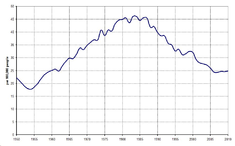Finno-Ugrian suicide hypothesis

The Finno-Ugrian suicide hypothesis proposes to link genetic ties originating among Finno-Ugric peoples to high rate of suicide, claiming an allele common among them is responsible.
Udmurts have been found to have a three times higher suicide rate than Finns and Hungarians. It has been thus theorized that such a possible allele may have arisen in those populations.[citation needed
]
However, contrary to the hypothesis, available contemporary (1990–1994) suicide rates in the United States were uniformly negatively associated with the proportion of the population comprising people of self-reported Hungarian, Lithuanian, Polish, Russian, Slovakian, or Ukrainian descent. The findings of this first test outside Europe are therefore conflicting. A proposal based on the geographical study approach is offered to further the progress of investigations into the genetics of suicide.[2]
See also
References
- Voracek M, Loibl LM, Kandrychyn S (June 2007). "Testing the Finno-Ugrian suicide hypothesis: replication and refinement with regional suicide data from eastern Europe". Perceptual and Motor Skills. 104 (3 Pt 1): 985–94. S2CID 19673570.
- Voracek M, Fisher ML, Marusic A (October 2003). "The Finno-Ugrian suicide hypothesis: variation in European suicide rates by latitude and longitude". Perceptual and Motor Skills. 97 (2): 401–6. S2CID 35277725.
